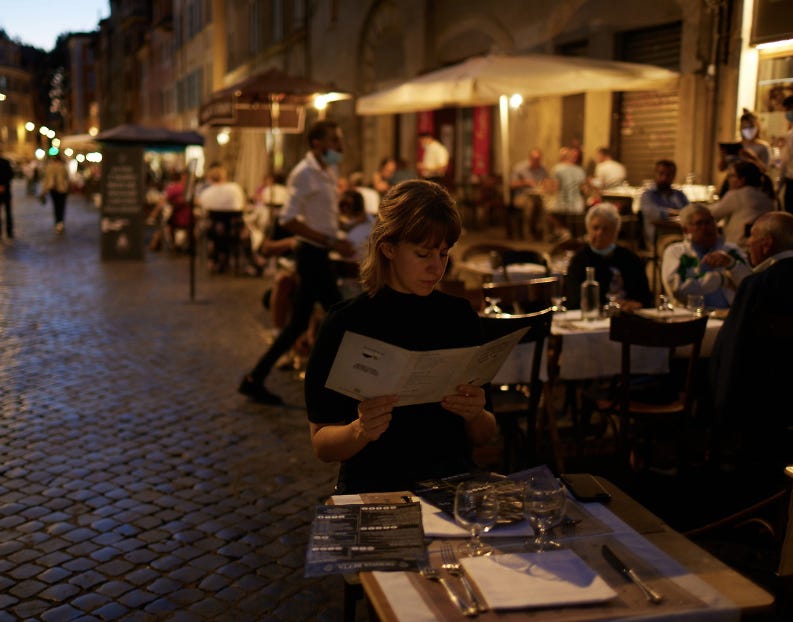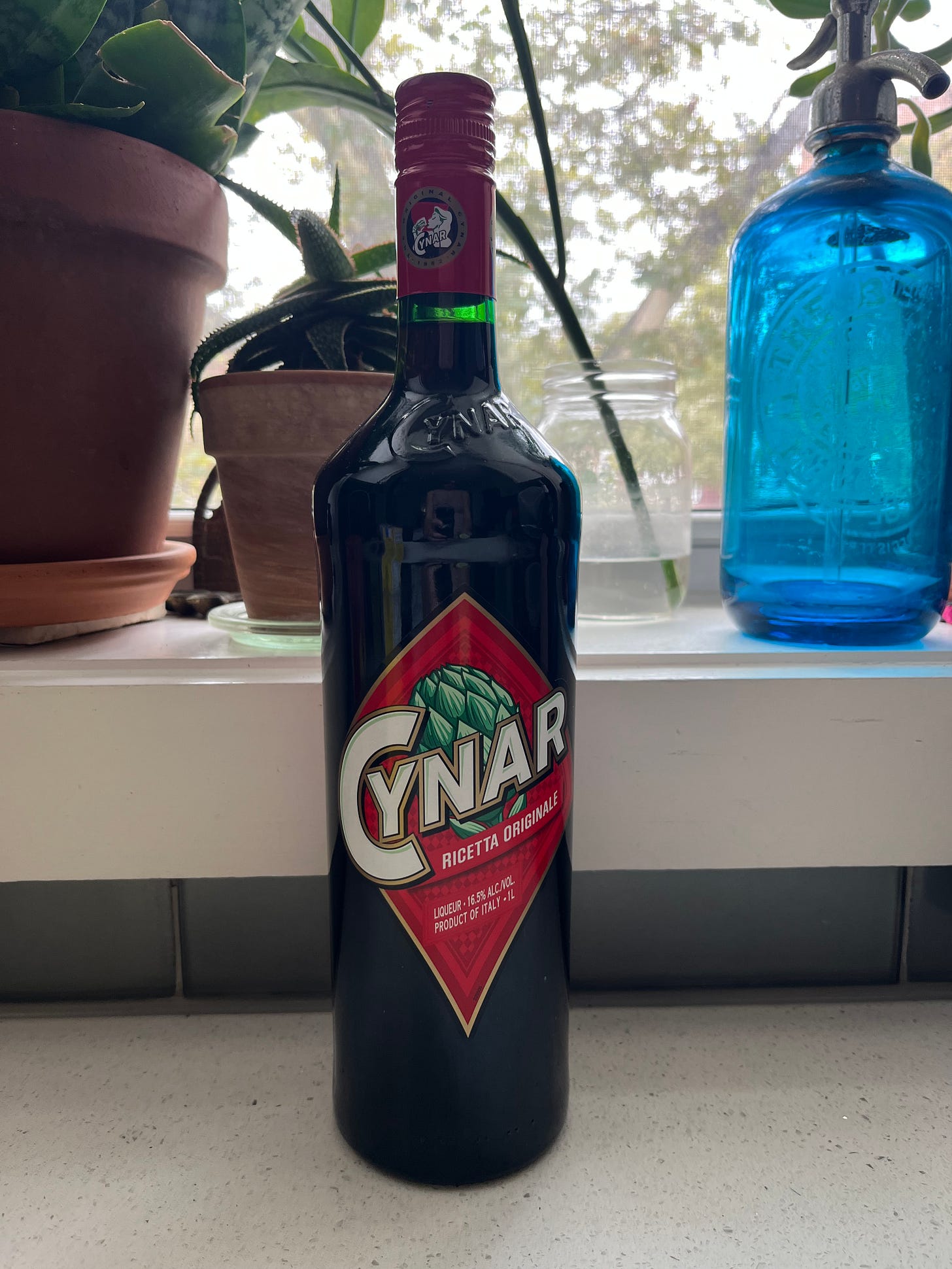Cynar Spritz
Plus: A big, sappy toast to celebrate PORTICO’s publication date!
She’s here friends, and she is beautiful.
After a year + of research, writing, and testing 100 recipes, another year for edits, photography, and design, and months of anxious waiting for the physical book to be printed and shipped to stores, PORTICO: Cooking and Feasting in Rome’s Jewish Kitchen (W.W. Norton) is officially out today.
I am so proud of this book. It is an honor to help share the stories behind Rome’s 2,000-year old Jewish history and introduce readers to the vibrant community that keeps the traditions, and amazing cuisine, alive today. The time I have spent in Rome over the years has shaped the trajectory of my life tremendously—both professionally and personally—so I am grateful for the opportunity to tell some of that story in the pages of PORTICO too.
The response I’ve received from advance readers (and the lucky folks who somehow got their preorders early) has been overwhelming. Watching a book connect with readers is the best feeling imaginable, so thank you for letting me know. You are all so kind, and I have been a weepy mess.
In celebration of publication day, I’m sharing PORTICO’s introduction in this week’s newsletter. (Scroll down to read it). I hope it illuminates why Rome’s Jewish history is so special and important to document. I also hope it makes you hungry.
And to toast publication day, I’ve got something very special for you—a recipe for my favorite Italian aperitivo, the Cynar Spritz. Find out more about this special cocktail and get the recipe below. But first….
PORTICO Cookbook Club
I’m so looking forward to our first PORTICO Cookbook Club! Mark your calendar for September 13 at 7:30 EST.
I’ll demo how to make the Stuffed Tomatoes with Rice (Pomodori con Riso) from PORTICO (pictured above), which is a perfect late-summer dish, and would make a delicious Rosh Hashanah side or vegetarian main.
You can either cook along in your own kitchen, make the dish ahead of time and share your experience, or just come to hang out. It’s going to be a fun, interactive, and delicious time, and I’m delighted to see you there (virtually)!
Paid subscribers of The Jewish Table: If you are planning to join, please send me an email or comment below so I can make sure to send you the Zoom link.
Okay, What the Heck is a Cynar Spritz?
Great question. Cynar (pronounced chee-nahr) is an Italian amaro—a bittersweet herbal liqueur distilled from a blend of 13 botanical ingredients. The most notable ingredient is artichoke—so much so that the bottle’s red label is emblazoned with an illustration of the edible thistle. (Just like PORTICO’s cover!) Like other amari, Cynar’s flavor skews bitter and complex—a little like Coca Cola without the intense syrupy sweetness, and with a pleasantly herbal vibe. It’s a little bit medicinal…but in a good way.
Cynar can be served neat or on the rocks, but my favorite way to drink it is as a spritz, mixed with Prosecco and twisted with lemon or orange. The Amaro Spritz does not share the sunset-colored flamboyance of its more famous cousin, the Aperol Spritz. According to Food & Wine the Cynar Spritz is this summer’s “ugly duckling” cocktail. But I love it precisely for its understated beauty.
It is also a fitting drink to toast with this week because way back in March, when PORTICO first became available for preorder, I celebrated with a fantastic solo meal at Via Carota in the West village. I kicked off the meal, enjoyed at their elegant bar, with their impeccable take on a Cynar Spritz.
Whether you make your own spritz at home, or choose to toast with wine, seltzer, or iced coffee, cheers to PORTICO, and cheers to everyone here who makes the work I do so meaningful.
Saluti and Buon Appetito!
Cynar Spritz
Makes 1 cocktail
Cubed ice for the glass
2 parts Cynar
3 parts Prosecco
Splash of club soda or seltzer (I used orange seltzer)
Optional: an orange or lemon wheel, meaty green olives, or a couple of Luxardo cherries, for serving
Fill a Rocks or Old Fashioned glass with ice (or use whatever you have that is a similar size). Pour the Cynar and Prosecco overtop. Top off with the soda, stir gently, and garnish as desired.
Introduction to Portico
Reprinted, with permission from Portico: Cooking and Feasting in Rome’s Jewish Kitchen, by Leah Koenig (W.W. Norton and Co., 2023)
Inside the bakery—a corner storefront no larger than a university dorm room—customers jostle at the counter for service. Just outside the doors, the line of hopefuls stretches half a dozen deep. Two display cases hold the array of sweets these folks are after: double-crusted ricotta and sour cherry tarts, chubby amaretti, and bar cookies studded with almonds and candied fruit, all blistered and molten from the bakery’s ancient ovens.
The shop’s swirl of sugar and good-natured chaos could easily be found in Brooklyn or down a Jerusalem side street. But this bakery, the 200-year old Pasticceria il Boccione, is on Via del Portico d’Ottavia—the main drag in Rome’s Jewish Ghetto neighborhood. And it is not alone. Up and down the street, restaurants and shops serve up classic dishes from la cucina Ebraico-Romanesca (Roman Jewish cuisine)— sultry beef stew spooned over rigatoni, oil-drizzled tomatoes roasted to the point of collapse, rosemary-scented lamb and potatoes, and whole artichokes deep fried into crisp, salt-kissed blossoms.
Rome’s Jewish community dates back more than 2,000 years, and is home to three distinct, but overlapping communities. The first, Italkim, date their ancestors’ arrival to Rome back to the 2nd century BCE. The second, Sephardim, arrived after the Spanish Inquisition. And the third, Libyan Jews, immigrated in the late 20th century. Through the centuries, the community has been shaped by both the creative and determined people who live there, and vast periods of unthinkable discrimination and hardship. But out of strife grew a resilient, deeply-knit community, and a beguiling cuisine.
I first visited Rome in 2004, when I was 22. A newly-minted college graduate, I was en route to Tuscany where the plan was to commune with the vineyards at an organic winery for a month and emerge with a greater knowledge of sustainable viticulture and, hopefully, a deeper understanding of myself.
The days I spent in Rome were filled with a mix of marveling at the Colosseum and Sistine Chapel, getting lost down Rome’s endless labyrinth of tiny streets and charming piazzas, spending my limited Euros on rectangles of Roman pizza, and navigating the strange social world that only exists inside of youth hostels. I made the briefest of forays into the Jewish Ghetto neighborhood (named for the 316 years Rome’s Jews were forced to live inside a walled slum) and felt some amorphous stirrings of connectedness. But I was too young and distracted to follow the feeling any further.

I returned to Rome five years later on my honeymoon, and this time, I was ready. My connection to my own Jewish heritage was more fully developed, and my interest in the link between food and Jewish history was in full bloom. My husband Yoshie and I wound our way up and down Via del Portico d’Ottavia’s smooth cobblestones, eating our weight in fried artichokes.
We took a tour of the Ghetto with historian and tour guide Micaela Pavoncello that left me dizzy with wonder at how Rome’s Jewish community managed to survive for twenty-two centuries, and find moments of joy and meaning in the most hostile of circumstances. We also lucked into a Shabbat dinner invite at the home of Giovanni Terracina, who founded the kosher catering company Le Bon Ton. Yoshie and I were embarrassingly well fed that evening, and walked home arm-in-arm, happily tipsy and baffled by our good fortune.
That Shabbat dinner completely exploded my previous understanding of what Jewish cuisine was and could be. The dishes Giovanni served—including chicken meatballs in tomato-celery sauce and a rich beef stew perfumed with red wine—were unlike anything I had eaten for Shabbat before. But around his gracious table, where we talked, laughed, and raised our wine glasses like old friends, rather than people who had just met hours before, they felt deeply familiar. The dishes he served were neither Ashkenazi (hailing from Central and Eastern Europe), nor Sephardi (hailing from the Iberian Peninsula). They were uniquely Roman, and they were incredible.
It is not an exaggeration to say that that trip to Rome solidified my desire to dedicate my professional life to studying and sharing Jewish cuisines from around the world. Time and again over the last decade and a half, I have fallen in love with unfamiliar-to-me corners of the Jewish food world. But it all started in Rome. So while I have included a handful of Roman Jewish dishes in my other cookbooks, Portico is my dedicated attempt to give something back to the city that has been so generous and inspiring to me.
I researched and wrote Portico in the midst of the Covid-19 pandemic. For the first many months of the process, I could not travel for research, and so relied on books, phone calls, and video chats to connect me to the city’s people and their kitchens. During those months of learning, I longed for nothing more than the chance to walk down Via del Portico d’Ottavia again.

A few months before my manuscript deadline, the world finally opened up enough for me and the book’s photographer, Kristin Teig, to fly to Rome. After settling into the Airbnb and taking a quick nap, we grabbed our notebook and camera, respectively, and set off toward the Ghetto neighborhood. It had been years since my last visit, but somehow my feet remembered the way. Despite the prevalence of face masks, everything—the sunlight glinting off the Tiber River, the majestic dome of the Tempio Maggiore (Great Synagogue) rising into the skyline, the overlapping bustle of tourists and locals stopping into the bakery or twirling spaghetti topped with sautéed artichokes at one of the tables lining the street—was just as I remembered it.
The Italian word casereccio, translates to “homemade,” and is used to describe a sense of things that feel homey—cozy, relaxed, inviting. (Yiddish speakers have a similar word, haimish.) Whether you have traveled to Rome a million times or hope to make your first trip soon, and whether you come from a Jewish background or not, I hope that reading and cooking your way through this book gives you the feeling of simultaneously being transported to Rome, and coming home.







Hi! Looking forward to the Book Club! Ritakoplin@gmail.com
Please add me to the Zoom list for the Portico Cookbook Club. I just got notification that my copy of Portico is being shipped, and I’m so excited!